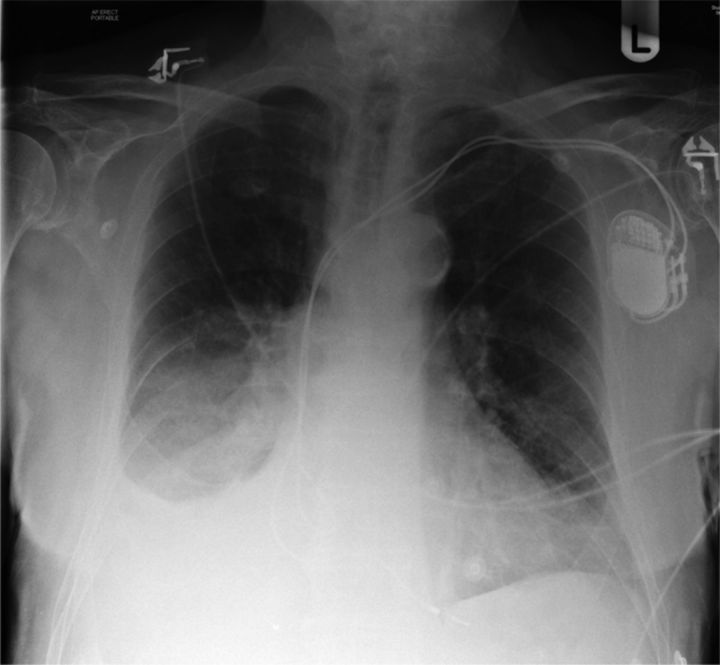Abstract
Pasteurella multocida is a non-motile, faculatively-anaerobic, gram-negative bacillus associated with a spectrum of human disease.1 Direct and indirect zoonotic transmission is recognised with animal bites being most frequently encountered as a result of salivary colonisation in farm and domestic animals.2 Despite the prevalence of P. multocida in swine herds,3 the relationship between porcine colonisation and human disease is poorly established. This lesson reports a previously unrecognised mode of zoonotic transmission in respiratory pasteurellosis; domestic cooking of pig trotters.
Lesson
An 81-year-old man presented with a four-day history of worsening shortness of breath, mucopurulent cough and fever. He was an ex-smoker (120 pack-years) with a background of chronic obstructive pulmonary disease (COPD). On admission he was tachypnoeic, pyrexial (temperature 37.9°C), tachycardic (122 beats per minute) and hypotensive (92/48 mmHg) with decreased breath sounds, dull percussion note and coarse inspiratory crackles at the right lung base. Blood investigations revealed leucocytosis 16.1×109/l with neutrophilia, C-reactive protein (CRP) 341 mg/l and type 1 respiratory failure (PaO2 6.7 kPa, pH 7.367, PaCO2 5.6 kPa).
Chest radiograph and ultrasound imaging confirmed a moderately-sized right pleural effusion with multiple septae and consolidated lung (Fig 1). After initial resuscitation and empirical intravenous co-amoxiclav, a chest drain was inserted. Pleural fluid analysis revealed an exudate (30 g/l protein) of numerous neutrophils and no malignant cells. Gram stain revealed gram-negative bacilli identified as P. multocida on culture. Sputum culture grew Pseudomonas aeruginosa only. Despite amoxicillin sensitivity of Pasteurella spp. resistance was identified to Pseudomonas spp. and accordingly single-agent imipenem was employed to target both organisms.
Fig 1.
Anterioposterior erect chest radiograph demonstrating a right pleural effusion with consolidated lung and a dual pacemaker in situ.
Following an initial fall in inflammatory markers CRP remained elevated at approximately 100 mg/l and repeat ultrasound imaging showed multiple small loculations unsuitable for tubal drainage. Thoracoscopic decortification was considered too high risk. Consequently, medical treatment continued with a 21-day course of intravenous imipenem followed by four-weeks of oral amoxicillin. Complete recovery was observed eight weeks after presentation.
In view of isolation of P. multocida, detailed questioning established that the patient had no domestic pets and denied feline, canine or farm exposure, foreign travel or exposure to unwell contacts. The only possible exposure to P. multocida was five days prior to the onset of symptoms when he soaked pig trotters in salted tap water at room temperature for 48 hours before boiling uncovered for one hour and ingesting as his evening meal.
Discussion
Human respiratory tract pasteurellosis has been noted as epiglottitis, sinusitis, tracheobronchitis, pneumonia and empyema formation.2 Pathophysiology of infection is underpinned by oropharyngeal colonisation. In healthy individuals and asymptomatic patients with COPD, colonisation has been reported at 5% and 25% respectively, accounting for variation in isolation and clinical signifance.2,3 Aerosol inhalation of the microorganism is therefore an important step in the development of oropharyngeal and tracheobronchial tree colonisation. Underlying lung disease, advancing age as well as concomitant immunosuppression are thought to further determine subsequent development of respiratory tract disease and in part correlate with an associated mortality of 31% in P. multocida associated pneumonia.2,3
P. multocida is a commensal of swine respiratory and gastrointestinal tracts and survival of P. multocida at scalding water tank temperatures is thought to explain contamination of most pigs during slaughter.3 It is therefore speculated that P. multocida colonises pig trotters and in this case physically agitating the organism during soaking and cooking allowed fragmentation of biological material originating from porcine saliva or faeces. Transmission is likely to have been facilitated by uncovered boiling of the pig trotters which would not have killed P. multocida but rather promoted further airborne spread of droplets containing this unusual and virulent pathogen.
Reference
- 1.Murray PR, Baron EJ, Pfaller MA, Tenover FC, Yolken RH. Manual of clinical microbiology, 7th edn. Washington DC: American Society for Microbiology, 1999. [Google Scholar]
- 2.Breen D, Schonell M, Au T, Reiss-Levy E. Pasteurella multocida: a case report of bacteraemic pneumonia and a 10 year laboratory review. Pathology 2000;32:152–3. [DOI] [PubMed] [Google Scholar]
- 3.Marois C, Cariolet R, Morvan H, Kobisch M. Transmission of pathogenic respiratory bacteria to specific pathogen free pigs at slaughter. Vet Microbiol 2008;129:325–2. 10.1016/j.vetmic.2007.11.030 [DOI] [PubMed] [Google Scholar]



